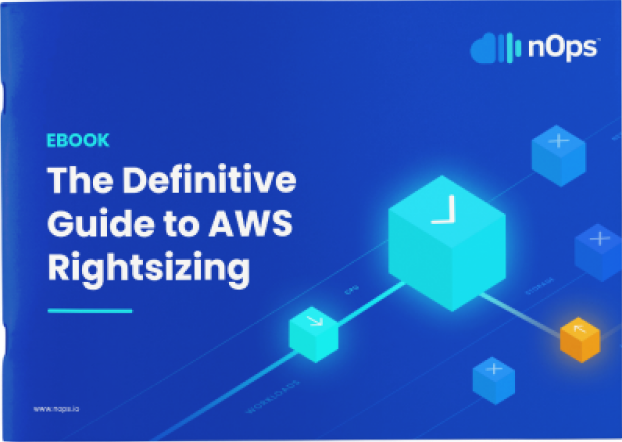© nOps 2025. All Rights Reserved.
Featured Ebook The CFO’s Guide to AWS Commitments - Download Now

Organizations that have deployed AWS usually have several EC2 instances running in their deployment. Often, these organizations pay for these instances but don’t use them to their full capacity. Failing to consider EC2 rightsizing is one of the major causes of cloud waste. If you’re tired of spending money you don’t have to on your AWS bill, here’s an AWS EC2 rightsizing guide.

Use the AWS Well-Architected Framework as best-practices guidelines for assessing cost optimization. You’ll understand the implications and trade-offs of your current decisions and identify opportunities for improvement.
Pay particular attention to memory and CPU usage. Eliminate underutilized and idle EC2 instances. As a rule, rightsize instances with maximum CPU usage and less than 40 percent memory for more than a month.
As your organization monitors current performance, you also need to identify usage patterns to inform your rightsizing decisions.
The easiest way to cut costs is to terminate all instances you no longer use. Generally, you should stop or terminate any EC2 instances that have been idle for more than two weeks.
You can rightsize an EC2 instance by migrating it to a different model within the same instance family. Consider vCPU, network throughput, memory, and temporary storage while choosing the model. Alternatively, you can migrate it to another instance family.
Amazon RDS is powerful and extensively customizable. However, it comes with a complex pricing model that makes it hard to predict costs. As a result, your monthly AWS spend can grow quickly and unexpectedly. Here are some timely tips to help with RDS rightsizing.
The AWS Well-Architected Framework provides best practices guidelines that can help organizations to evaluate their deployments and implement designs that can scale over time. You can use Well-Architected to identify the pros and cons of your current rightsizing decisions.
Use tools, such as CloudWatch, to check database connections to your RDS instances. Downsize, stop, or snapshot and terminate instances with zero connections.
Downsize RDS instances that have less than 50 percent CPU utilization to lower instance classes.
Make sure you properly tune DB queries. Optimize tables, create the right indexes, remove redundant indexes, rewrite queries to reduce the data set, and optimize joins. If the RDS load reduces, you can move it to a lower instance class to cut costs.
RDS comes with high availability and excellent failover support for DB instances by employing Multi-AZ deployments. But Multi-AZ deployments cost twice as much as single AZ deployments. Disable Multi-AZ if you don’t need it.
Pay attention to storage costs. Moving your instances to newly launched gp3 volumes will save you up to 20 percent in costs than using gp2 volumes. It also performs better than gp2. In some cases, gp3 volumes are better than io1 and io2.
Implementing data caching leads to lesser load times in some RDS instances. As a result, it’s possible to downgrade instance types without drastically affecting performance.
Ensure all RIs are in use. If there are unused instances, change the instance type of any RDS to ensure you’re using all RIs.
To make rightsizing easier and more effective for teams, Datadog and nOps have partnered together. Via a one-click integration with no additional costs or steps, nOps builds on the end-to-end visibility provided by Datadog to revolutionize your rightsizing and commitment management.
Datadog’s cloud monitoring and analytics provides engineers with real-time coverage of resource-level insights such as memory, CPU, and storage — granting nOps full visibility into the exact data needed for 100% accurate rightsizing recommendations.
nOps’s automated FinOps platform then makes it insanely easy for engineers to take action. Via integration with your tools and frameworks (Terraform, Eventbridge…), nOps fully automates months of work to apply recommendations into mere seconds.
Here’s how this natural partnership is changing the game. It grants you:
Complete Rightsizing Confidence. Datadog’s comprehensive logging and monitoring data is fed into nOps’s state-of-the-art ML engine. These data-backed recommendations are visualizable in an easy-to-scan dashboard which proves reliability and accuracy to engineers beyond a shadow of a doubt — giving them the confidence to act on recommendations.
Hours of Time Savings. With the platform, it takes five seconds to make a changeset, accept the changeset, and push it out. nOps automates away all the work and complexity, freeing up engineers to focus on other meaningful projects. One click to accept the recommendation and you are done.
Vast Cost Savings. When engineers don’t act on rightsizing recommendations, underutilized and idle resources continue to drive unnecessary AWS costs — leading to thousands in missed savings accumulating every day. nOps make it completely pain free and effortless for engineers to actually act on recommendations for up to 50% in immediate cost savings.
Risk free, hands-off commitment management. Once you accept rightsizing recommendations, nOps automatically provisions and deprovisions commitments into your environment. As a result, you benefit from the savings of RIs, with all the flexibility of on-demand.
nOps was recently ranked #1 in G2’s cloud cost management category — and together with Datadog, the savings are reaching new heights.
Join our customers already using nSwitch Essentials for up to 50% in immediate cost savings by booking a demo today!
Oversized or overprovisioned? Time to look into your resources and rightsize with one click



© nOps 2025. All Rights Reserved.